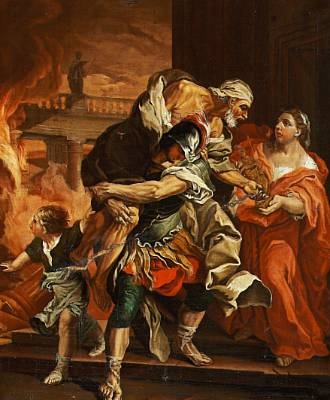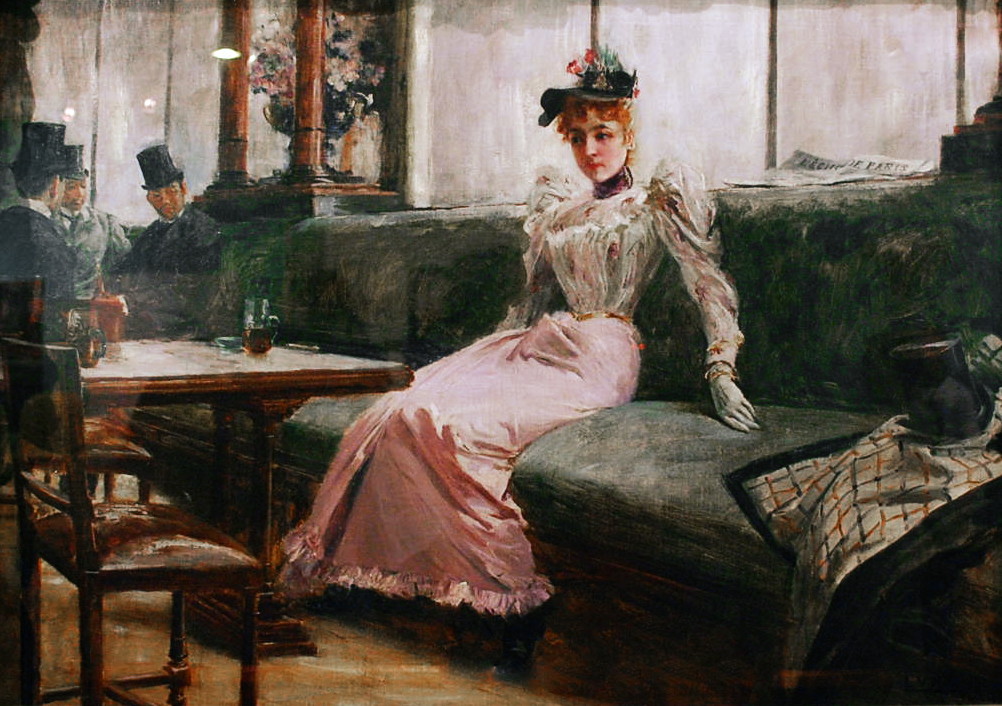The MMFF entry "Ang Larawan," (Dir. Loy Arcenas, 2017) which was based on the musical, which in turn was based on the play by Nick Joaquin and translated by Rolando Tinio, poses quite a financial situation still relevant to a lot of Filipino families. How does one prepare for retirement and old age, particularly if one is (a) an artist and (b) a single and unmarried female dependent on other family members. Of course, there is also the question of how Pinoy society values art. But at the moment, I'm interested in how can art be a vehicle for retirement.
The painting in contention was created by Don Lorenzo El Magnifico, supposedly a contemporary of Juan Luna. He crafted an obra maestra in his old age, and mostly everyone observed that The Portrait of the Artist as Filipino did not appear to be Pinoy at all in terms of imagery. It showed a scene from Virgil’s Aeneid: Aeneas carrying his aged father Anchises away from the burning city of Troy. The painting was said to be a self-portrait: it was effectively a young Don Lorenzo carrying his old self away from destruction.
After painting this obra, he suffered an accident—fell from a second storey window and down into the courtyard. He was checked by all the doctors and nothing was wrong with him, and yet he refused to leave his room.
The painting got people interested in an old master that they thought was already dead. A Frenchman raved about it; an endless stream of students, journalists, photographers and critics trooped to the Marasigan house to view the painting—much to the consternation of his two old maid daughters Candida and Paula, to whom he has bequeathed this masterpiece.
 |
| Similar subject by Italian painter Pietro Testa. |
The daughters face a difficult situation: they are dependent on padala of their two elder siblings Manolo and Pepang for their expenses and the house’s upkeep. Candida and Paula have even taken in a boarder whom they despise: Tony Javier was a vaudeville piano player. Unschooled but ambitious, rakish and brings home rowdy women, drinks chocolate lecherously from someone else’s cup. But his rent brings them money, so they tolerate him.
But even that doesn’t seem to be enough as Candida and Paula do not have enough to pay the bills from the kuryente, the tubig. The sisters have a plan: Candida considered a newspaper ad where one would get paid to catch and kill rats just so they could pay bills. Paula could put up a signs outside the house announcing that she could tutor females how to play the piano, and males on how to speak Spanish—frankly a skill that was disappearing in 1941, on the edge of a war and a Philippines that has been under American rule for decades. Manolo and Pepang didn’t like this plan: they asked the sisters to take down the signages outside the house (Nakakahiya!). They planned to sell the house, take the furniture for their own children who are about to get married and start families of their own. What’s worse is they planned to separate the women, take one each to care for their own households. Such is the fate of dependent elder unmarried women at the time.
The one thing that could save Candida and Paula from financial ruin was The Painting which their father told them to do as they pleased. Tony Javier has a ready buyer, an American willing to pay $10,000 plus his commission for convincing the sisters to sell. The sisters are unwilling, but Tony lists all the things even he could do with his own commission: go wherever he wanted, to go to Europe, to South America, finally formally study the piano, breathe in some culture. It would buy him decency away from his very precarious situation.
Tony Javier enticed the sisters with this possibility of financial freedom, of no longer worrying about the bills, what the neighbors would say, doing whatever he wanted without fear. All this for ten thousand dolares in exchange for a painting done by their dear old dad. So a question: How much was Don Lorenzo El Magnifico's painting worth? Can art be a valid nest egg for retirement and financial freedom?
In the movie, the price of the painting was $10,000 in 1941, which was something like Php20,000 at the time. So there was a 1:2 ratio in the exchange rate. I tried to find out what the painting could cost now.
calculator.net computes for inflation using US CPI data. I plugged in $10k in 1941 and that amounts to $172,216.04 in 2017. At the current exchange rate of Php49.94:US1, it means that $172,216.04 (49.94) = Php8,600,469.04.
 |
| Ronald Ventura's "Grayground" was sold for nearly Php47M. |
Php8Million for the work of an old Philippine master seems like peanuts. It should cost more, specially taking into account that even relatively young Philippine artists are topping out at USD1Million per work. There’s Ronald Ventura’s “Grayground” for Php46.9M or Geraldine Javier’s “For She Loved Fiercely” which sold for HKD 1.46M or Php8.8M. A Fernando Amorsolo painting done in his prime sold for Php20M at an auction. National Artist BenCab’s “Sabel” fetched Php20M. The biggest “Sabel” was priced at Php46.7M.
For comparison, I looked up the price of a Juan Luna painting in the market. That same article which sold the “Sabel” mentioned an “untitled Luna” featuring a lady dressed in the fashion of the time sold for Php14M. Perhaps the most controversial Luna piece in recent memory was “Parisian Life,” which was purchased by the GSIS at an auction in 2002 for Php40M. It caused an uproar at the time, and for which the GSIS caught flak for “wasting the public’s money” for an artwork. But the painting is now valued at Php300M, which was 650% higher.
 |
| Juan Luna's "Parisian Life," bought by GSIS for Php40M in 2002. |
In the film, Manolo and Pepang brought in the women’s godfather, a senator of the republic, to convince them to sell the painting to the government. It seemed like an echo of the government trying to buy the painting to preserve culture and memory, and at the same time, the sisters could have funds to care for themselves.
 |
| Juan Luna's "Espana y Filipinas" was worth Php156M. |
Don Lorenzo’s self-portrait was smaller than Luna’s “Spolarium" but bigger than “Parisian Life.” It should be priced similar to a rare Luna "¿A Do...Va la Nave?” that sold also at a bidding for Php46.7M or to a version of "Espana y Filipinas," which was auctioned off for HK$25.88 million or Php156.52 million.
At its bare minimum, the work of an old master who was Luna’s contemporary should be priced in the vicinity of a “rare Luna” at Php8M minimum, to an intermediate price of USD1M similar to a young contemporary auction star. Or if we follow the auction for old masters, a major work should fetch anywhere from Php46M maximum or Php156M.
So anywhere from Php8M, 46M or 156M.
Even if “devalue” it by saying Don Marasigan was *not* Luna and slash the price by half, that would still be a decent Php4 to 20M, that should buy Paula and Candida a modest but secure retirement in their old age. But at 46M or 156M or even “Parisian Life” levels at 300M could buy them and their family financial security for generations.
ART FOR RETIREMENT
So is art a valuable and valid piece of investment for retirement? If it’s the work of an established master, yes. Just going by the appreciation of Luna’s “Parisian Life” from Php40M to 300M in 15 years is proof of that. Even a minor and rare Luna that sells for Php8 million is a godsend. But how many obras of old masters do we have lying around?
If you are young and can go “speculative,” I would probably get a major work by a relatively young and upcoming artist and hope he does well in the future so that the value of my purchase could appreciate in the decades ahead. Better if he becomes a National Artist.
SPOILERS AHEAD:
All the hypothetical pricing seems wasted as Paula decided to destroy the painting so they could be “free.” As in start from scratch. I could imagine Paulo Avelino's Tony Javier quaking in desolation as his future was destroyed just like that. But it wasn't his painting.


No comments:
Post a Comment